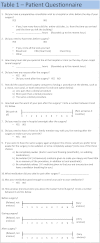The patient's perspective on carpal tunnel surgery related to the type of anesthesia: a prospective cohort study
- PMID: 24426892
- PMCID: PMC3574473
- DOI: 10.1007/s11552-012-9474-5
The patient's perspective on carpal tunnel surgery related to the type of anesthesia: a prospective cohort study
Abstract
Background: The purpose of this study was to provide prospective independently analyzed evidence on how patients feel about a carpal tunnel release (CTR) performed under local anesthesia only (no sedation or tourniquet) versus with local anesthesia, intravenous (IV) sedation, and a tourniquet.
Methods: This prospective cohort study compared 100 consecutive CTRs done with only lidocaine and epinephrine in Saint John, New Brunswick to 100 consecutive CTRs done with IV sedation in Davenport, Iowa. Patient perspectives on the anesthesia were captured in a blinded questionnaire 1 week postoperatively.
Results: For subsequent surgery, 93 % of wide awake patients would choose local anesthesia only and 93 % of sedated patients would choose sedation. Wide awake patients spent less time at the hospital (M = 2.6 h) than sedated patients (M = 4.0 h; p < .001). Preoperative blood work, electrocardiograms, and/or chest radiographs were done for 3 % of wide awake patients and 48 % of sedated patients (p < 0.001). Preoperative anxiety levels for wide awake patients were lower than for sedated patients (p = 0.007); postoperative anxiety was similar. There were no anesthesia complications in either group. Narcotics were used by 5 % of unsedated patients and 67 % of sedated patients (p < 0.001). Adequate pain control was reported by 89 % and 90 % of patients, respectively.
Conclusions: The majority of patients from both cohorts liked whichever method of anesthesia they received and would choose it again. However, sedated patients spent more time at the hospital, required more preoperative testing, and reported greater preoperative anxiety.
Keywords: Carpal tunnel release; Carpal tunnel syndrome; Intravenous sedation; Local anesthesia; Patient preference; Patient satisfaction; Wide awake.
Figures



References
LinkOut - more resources
Full Text Sources
Medical

